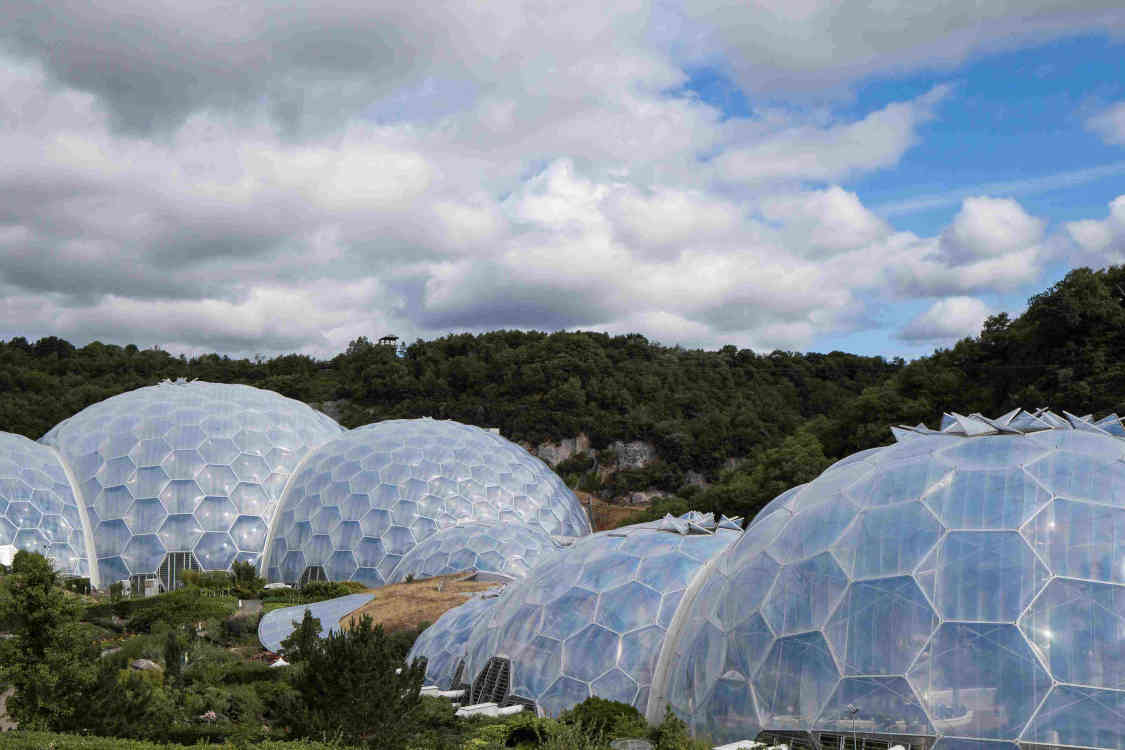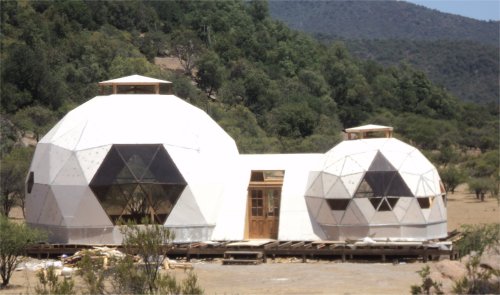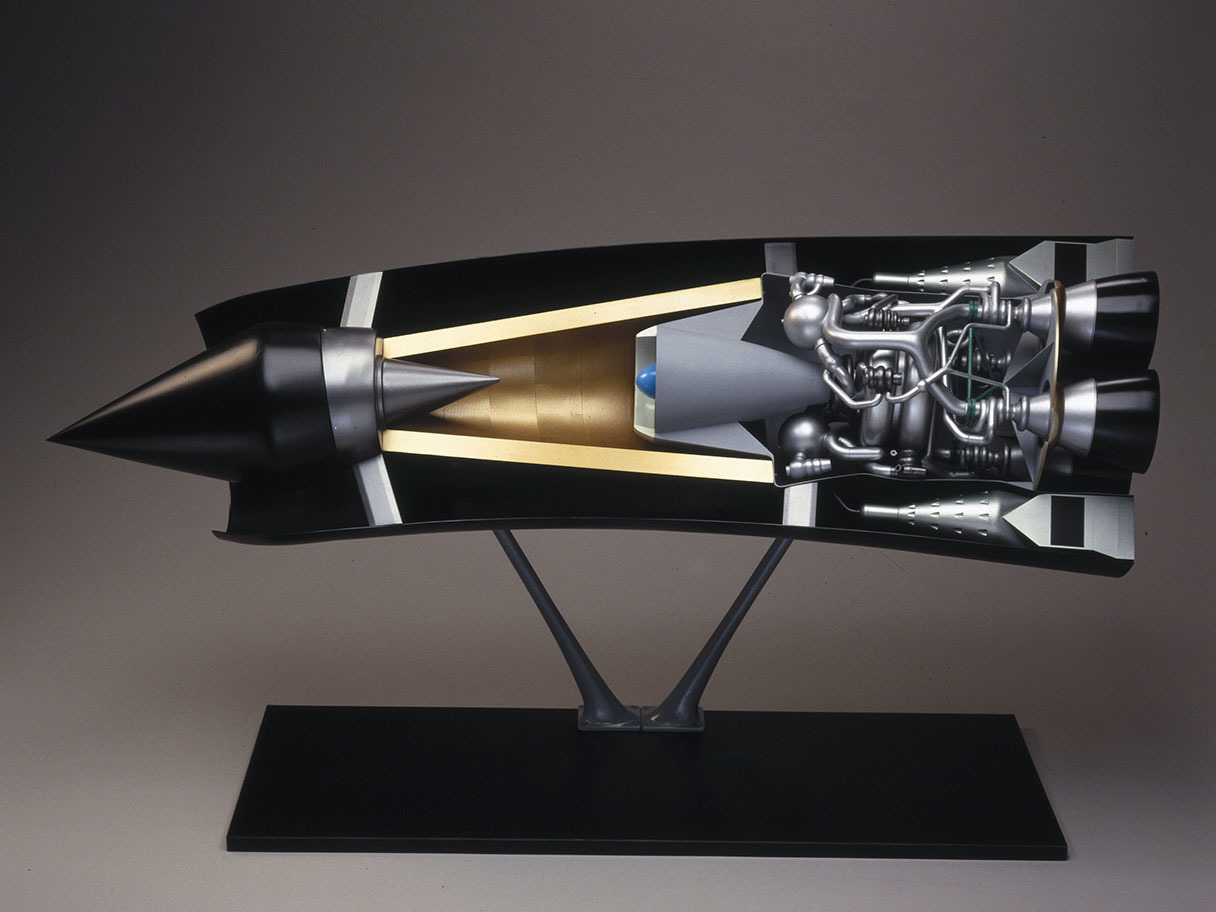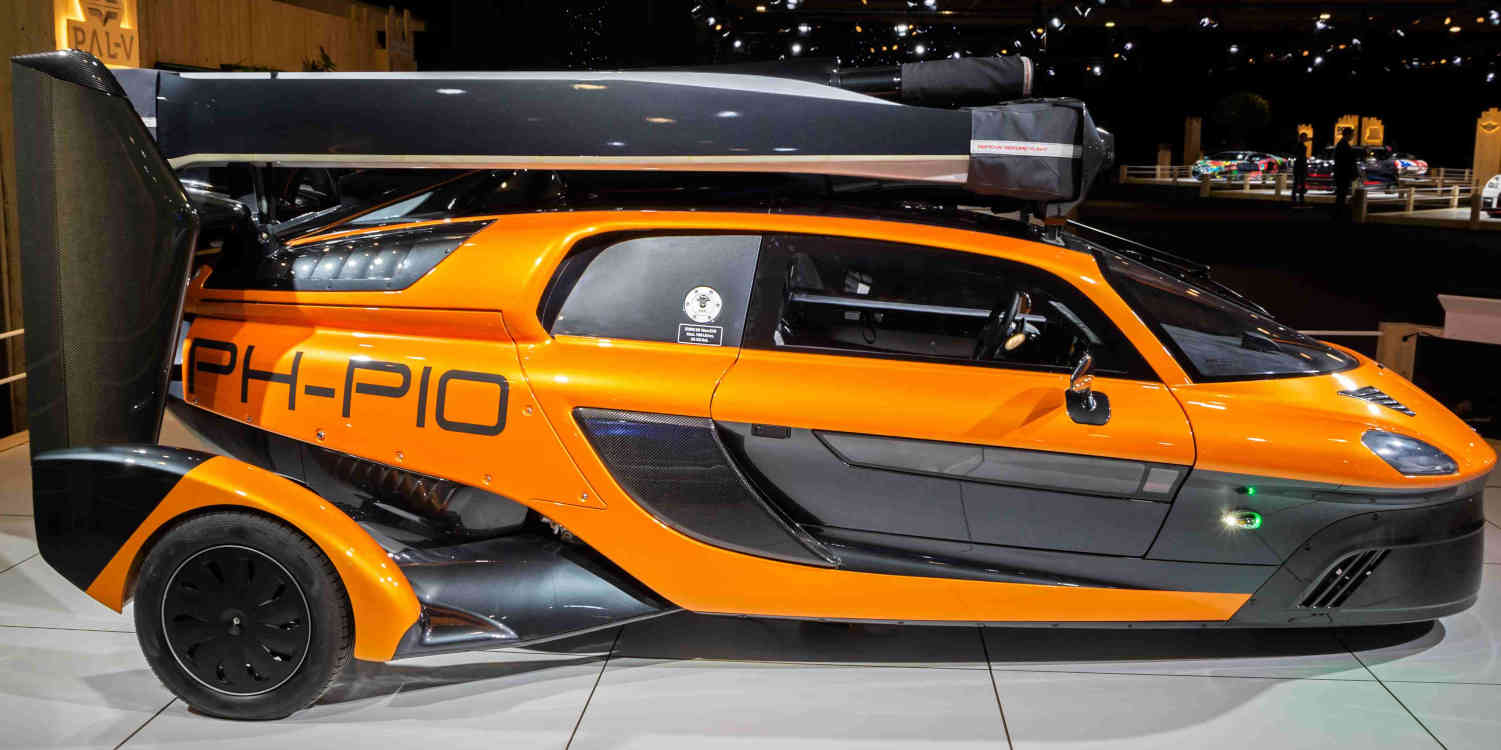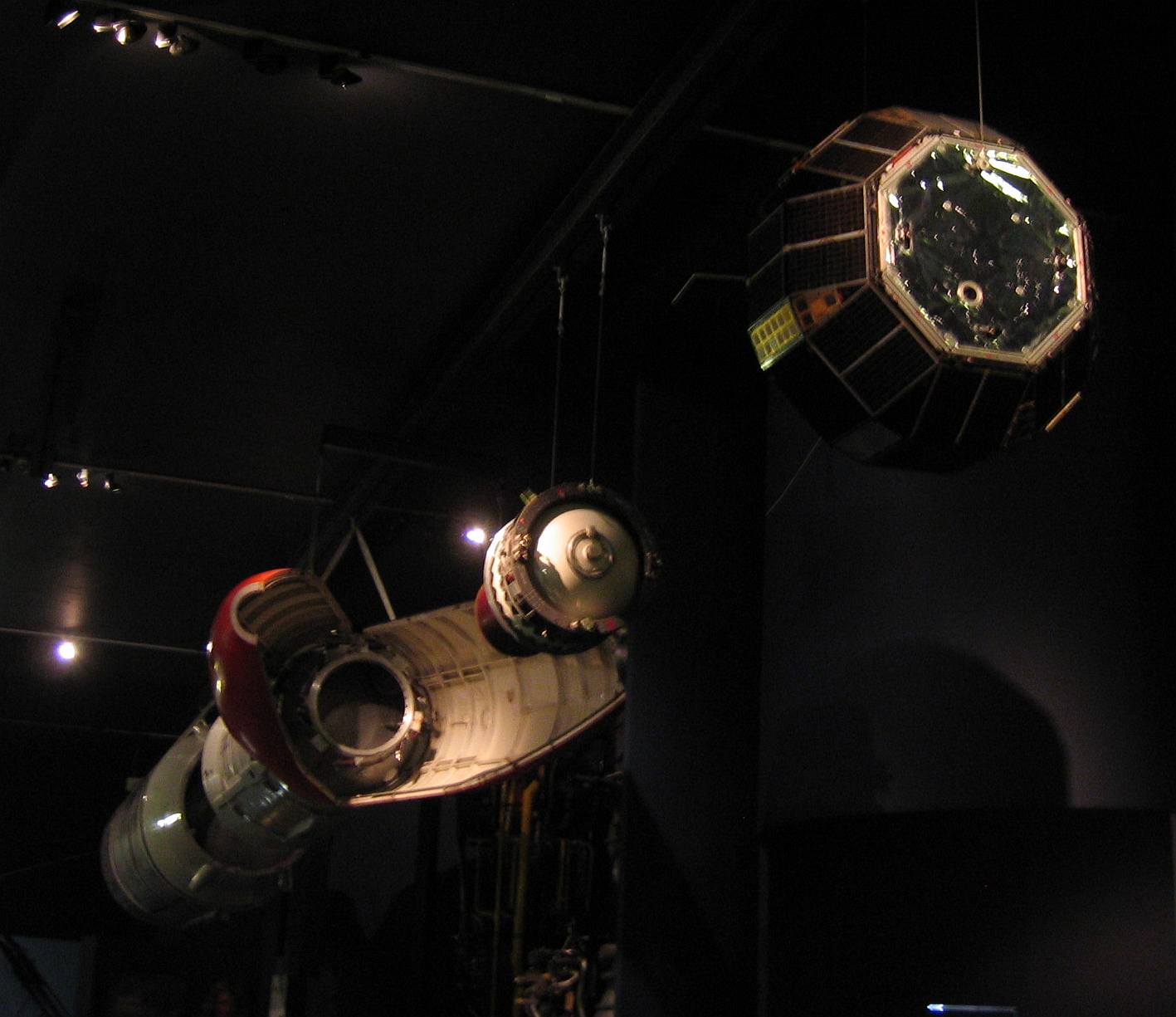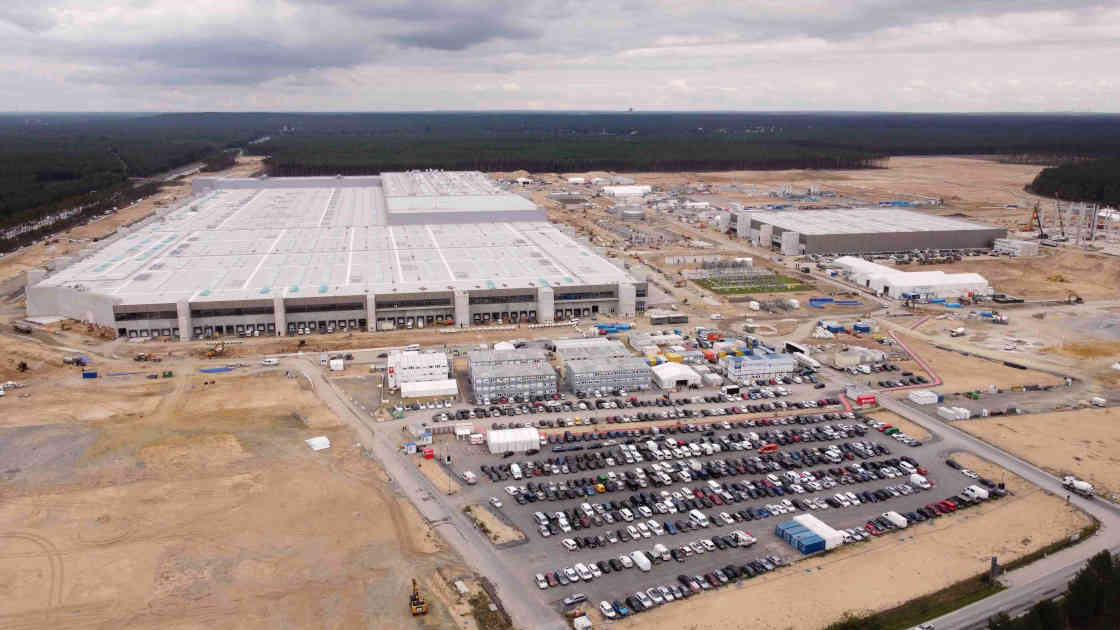Ideas 28-1...Zero Carbon Requires
Change In LifestyleWC Bill Larkins: Two UK built LearAvia Lear Fan 2100, at Reno in 1982 There has been little regional aid to speak of, other than for transport infrastructure, handed out by HMG, since the demise of Learfan twin engined single tail rotor executive aircraft and the De Lorean gull winged stainless steel sports car in Northern Ireland in the 1970s. This chapter contains images of such HMG supported projects that all failed due to party politics, lack of vision and negative media, including the hovercraft which now only travels to the Isle of Wight, Black Arrow satellite launcher, Prospero satellite and the tilting advanced passenger train. Prospero, which is still in orbit, was to be the forerunner of navigation, Earth and sea resources monitoring, weather monitoring, direct TV broadcast, navigation and ultimately data relay and internet satellites, investment in which would have reaped billions. And we must not forget the contribution British inventors made towards the jet engine, computer, radar, electronic navigation, automatic aircraft instrument landing system, black & white to 3D colour television, movie film, thin TV screens, etcetera. And where the hell did it get us? If these efforts had been financed by a sovereign wealth fund, then it is highly likely that UK workers would still be employed in such ventures. Since then there have been drastic redundancies in the civil service, which makes one wonder whether HMG can stimulate anything except executive's salaries, bonuses, golden handshakes and diamond pensions. With 1.2 million UK homes facing negative equity and over two million unemployed, there was little that HMG could include in a stimulus package that would get people to work their way out of debt? Inevitably such HMG financed projects would be at the cutting edge of technology in order to maintain skills and the nation's competitive edge. Rumours that the vast majority of British people fear science, may well turn out to be true. When AI and androids come along, the working class will not take kindly to the fact that HMG has relegated them to the second division, with no hope of improving their lot. AI will make just about everyone redundant, destroy consumerism and ultimately capitalism. So will there be a leisure orientated society, with people paid a national wage. HMG can't even create retirement camps for pensioners in that place in the Sun. And how the hell is HMG going to stop all these economic migrants getting their hands on it? Is there a strategic planning committe working on these problems?
Enough of the managerial problems, let's take a look at existing clean technology. Just where are we? Sadly the only clean technology used extensively today are photo-voltaics, wind farms, geothermal and hydro, the latter having ecological drawbacks in many locations.
HMG's stimulus plan includes property regeneration designed to counter global warming. Prime Minister Theresa May announced in 2019 an anti-global warming/stimulus plan. The opposition Labour Party has a similar plan. However, it is unlikely that UK homes will have external insulation if cheap nuclear fusion becomes a reality. As for PVA's, I fitted my own, as did many other home owners on my housing estate. In addition to heat pumps, homes will also need heat regenerators, which recover heat from expelled foul air. The alternative is an exhaust air heat pump, which provides both air heating by ductwork, plus ventilation. However, one third of the homes in the UK were built before 1914. It's estimated that each home would cost 17,000 pounds to upgrade. Do people really see themselves living in a Victorian home in the twenty-first century? Most of the rooms are simply too small for a modern lifestyle, whilst external and loft insulation does not keep a townhouse warm when the neighbours have gone to work, or gone on holiday. The party wall is not insulated, and even if it was, I and many other people would not be able to put their beds and other furniture back in the bedroom, etc. My home is only 5.25 metres wide. The present clearance between my bed and the two walls is only about ten millimetres, and I am not joking. Also I have double glazing front and rear, but no inert gas filling, no heat retentive glass and no insulation in the frame, and no certificate, although I did get insurance to cover that latter deficiency when I bought the place. No doubt many owners have not. And of course, being a home owner and no longer a tenant, how much is HMG going to screw out of me. As for being rewarded for all the effort we put in, take a look at the Dubai Expo 2020 exhibition in London. This is how HMG's designs for the future should be. We don't even have a minister for happiness. Dubai is in the United Arab Emirates, on the southern shore of the Persian Gulf. For inspiration, it may as well be on the other side of our galaxy.
There is a way of updating Victorian homes fit for the twenty-first century. You have to demolish every third home, and combine the other two. An insulated glasshouse will be used for hydroponic food production. The roof of the brick structures would be flat so that photo-voltaic arrays could be orientated always towards the Sun. The rear alleyway walls would be converted into buildings, possibly for rearing of rabbits, chickens and fish. Of course, as with every other expensive government initiative, will it have to be abandoned when the Greenland ice cap collapses? When you look at the next link, of Dubai, ask yourself the question, 'why doesn't our country look as good as this?' Much of it is being built by British companies employing British engineers.
Contrary to my initial views, wind turbines have become a huge 'success'. But are they, and will they stay, financially viable? The cost of electricity from wind turbines is about 57 pounds/MWhr, whilst electricity from the latest 22 billion pound Hinkley Point C nuclear reactor, being built by EDF, will be 92 pounds and fifty pence, over a 35 year period, as agreed with HMG. With the replacement of domestic gas central heating with heat pumps, and petrol and diesel vehicles with electric cars, the UK will be using three times more electricity than it does at present, by 2040 AD. And of course there wouldn't need to be so many homes to convert were it not for the fact that successive governments have broken up so many families, through casual divorce, women's lib and legalizing homosexuality. It's thought that there will be 100,000 children from broken homes in care by 2050 in the UK. And all those extra homes will need electric heating also. Already Toshiba and Hitachi have pulled out of nuclear power station construction at Moorside and Wylfa/Oldbury respectively. This leaves the French EDF and the Chinese company CGN to construct Bradwell and possibly Sizewell nuclear power stations. HMG has invited Rolls Royce to consider building at least ten Small Modular Reactors. These would be mini nuclear fission power stations costing about 1.8 billion pounds each, producing 440 MW for 60 years, at existing nuclear sites. They would be factory built and transported to site by road. Rolls Royce & Associates already build nuclear fission reactors for Trident submarines. With the technology proven in 2025, and the first power station in 2030, it would of course be competing with Tokamak Energy Ltd. Will the two technologies be built, or will only one, resulting in substantial cancellation costs to the tax payer? Of course, to start a nuclear fusion reactor, one needs a considerable amount of electrical energy, probably supplied by nuclear fission. Alternatively, HB11 fusion reactors may require relatively little energy to start up, and maybe light enough to be transported to the Moon and Mars where prolonged night time/sand storms make photo-voltaics and orbital power stations unreliable, whilst low temperatures make batteries suspect.
With the UK climate getting worse, due to hurricanes persisting longer over a warmer north Atlantic Ocean, will anyone want to live here in a world of AI produced unemployment. To find solutions to the global economy, one has to think out of the box. Should the British economy be diversified? With AI managing things, it's likely that it will, with androids doing the craft work. If natural economic and social forces are allowed to make their play, then it's likely that androids will inhabit the UK, whilst Britons travel the globe, polluting it, whilst enjoying the good life. In my opinion they should live in geodesic biomes. Such a structure gives maximum volume for the least building material. They are composed of mainly identical parts making it easy for the occupants to assemble, straight out of the shipping container. Humans would live in relatively small biomes, with larger domes nearby in which to produce crops of grain, etc.
SHUT: Eden Project, Cornwall, UK WC Australdechile: Cluster of Domes for Living Purposes WC Kbh3rd: Climatron Garden Glow WC William Starkey: Geodesic Dome HMG's stimulus plan should include, in addition to IT & AI mentioned elsewhere on this website, the following:
Ideas 19...Global Warming - Climate Change -
1...Skylon SpaceplaneWith Skylon operational, the cost of launching payloads into space will be greatly reduced. Competing against the USA's Falcon vertical landing launcher, prices are likely to be competitive. Satellites, space stations, space hotels, space probes and telescopes up to 12 metric tons (tonnes) in weight could be launched into Earth orbit. (Hyperlinks to 3D printing aerospace companies are at the end of the Man & Aliens in Space chapter.) Skylon has been redesigned with the help of Rolls Royce, with the engines being moved under the wings and the fuselage cross-section being rectangular instead of round, presumably to reduce the sloshing around of fuel in flight and altering its associated centre of gravity. There is also a quest to replace the helium cooling system with ammonia which could also be used to power the vehicle. The ammonia would be stowed in the wings of aicraft, including Skylon, and after being heated by waste heat from the jet engine, it would then pass through a catalyst where some hydrogen would be produced. The hydrogen and ammonia would then be ignited in the engines combustion chamber leaving no air pollution. The ammonia catalyst was developed by the UK's Science & Technology Facilities Council's Technology Dept. and at the Rutherford Appleton Lab's ISIS Neutron & Muon Source Research Facility. See the news section on the www.reactionengines.co.uk web site for details.
In October 2021 the UK excavator company JCB signed an agreement with Australian energy company Fortescue Future Industries for billions of dollars worth of hydrogen, along with Ryze Hydrogen who will manage distribution. Just which fuel source, green hydrogen, formic acid, HB11, solid state or lithium ion batteries, wins the day in powering heavy machinery, remains to be seen. And just what is the boil off rate for hydrogen when shipped from Australia to the UK? I assume it will be transported as ammonia, then converted by filtration to hydrogen shortly prior to usage. Green hydrogen, produced by electrolysis via electricity generated from photo-voltaics or wind, needs to be consumed quickly, since it can escape through the metal of its container. A release of more than 10% would not make it competitive. For this reason it's likely that it should only be used to fuel trains on non-electrified lines, aircraft, some ships, such as ferries and some industrial processes. However, battery technology is advancing so rapidly, it's likely that hydrogen may have no future, unless of course we can find below say 10,000 feet large deposits of white hydrogen.
WC: Science Museum London Skylon's SABRE engine It remains to be seen whether UK based company Clean Power Hydrogen can make its production commercially viable. Employing electricity from renewable sources to produce hydrogen, the bi-products are oxygen and heat, which are also put to use. Cheaper electricity from nuclear fusion, Small Modular Reactor, Travelling Wave Reactor and quantum photo voltaics, etc. plus greater power density in batteries makes the market hard to predict. The market should have leveled out by 2040.
Skylon's SABRE engines burn hydrogen, which is mainly produced by the electrolysis of water to produce hydrogen and oxygen. Hydrogen can also be produced from natural gas, methane. This process is called steam methane reformation that produces carbon dioxide as a bi-product. The CO2 is pumped underground into a disused oil or gas field, in order to prevent it acting as a greenhouse gas. This process is known as sequestration. An alternative fuel would be formic acid, which is easier to store, with no boil off.
In 2020, a second zero emission aircraft propulsion system was developed. It was announced by the University of Cambridge that they had produced an energy device that can mimic photosynthesis in plants to produce formic acid, from which you can easily extract hydrogen. The formic acid is produced by a photo catalyst plate composed of cobalt and semi conducting powders, submerged in water and carbon dioxide. Cheap production of hydrogen is essential for commercial aircraft propulsion and for formic acid fuel cell powered road and rail vehicles, and possibly ships. In fact anywhere where mains electricity is not available or insufficient. The spaceplane could be built at Birmingham International Airport, supported by a large pool of local engineers. The runway would not have to be lengthened since Skylon would only make sub-orbital flights from there to space launch locations. It will start a long awaited renaissance of the world's space industries. The benefits of such missions can only be inferred from the conquest of the Americas by Europeans since the dawn of time. In September 2020, the European Airbus consortium announced that it would build a range of ZEROe aircraft by 2035.
There is of course the question of affordability. That great frolic in the sky. The money could be better spent elsewhere. Right that does it. I am pissed off listening to such tripe. What about HS2 from London to Birmingham, Manchester and Leeds. As I write, the eastern branch to Leeds is being killed off by HMG. Just about everyone saying how it will somehow rejuvenate the north. The truth is that high speed rail links in a small country like the UK are pointless. HS2 will reduce travel time from London to Birmingham by 49 minutes, the total project costing from £75 billion to £106 billion. Of course, by the time it's completed in about 2035, executives will be travelling door to door in air taxis, whilst the rest of us travel in zero polluting computer driven taxi-vans, that is if entrepreneurs can pin down parliament to agree to legislate favourably for it. As for the Chinese, they will be travelling by 1000km/h intercity maglev. So much for keeping up with the Joneses. As for HS2 it will be completed decades after British Rail invented the high speed tilting train in 1970. Called the Advanced Passenger Train, and powered by either gas turbines or electric motors, it can now be seen at the Crewe Heritage Centre. It was killed off by the negative minded story seeking media.
Whether taxi vans will create a more healthy environment remains to be seen, for there are fears that volatile organic compounds will still be emitted from them, just as they are from cars with internal combustion engines. Compounds such as benzene and formaldehyde are 70% higher for electric vehicles at start up than for diesels. These pollutants come from tyres and brakes, although it is hoped that computer controlled power and braking systems will mitigate such emissions in the future. Central and local government in the UK have decided to install 26,000 charging points, whilst at the moment drivers of electric vehicles often cannot find a charging point because they are either out of action, have the wrong cable connection, don't accept the right debit or credit card, have a non charging car in the charging space, or can't be turned off when fully charged. 43% of charging points are in London and the south-east. 7,000 charging points are being made at the moment in 2021, with 35,000 per annum planned. HMG is financing the operation with £1.9 billion + £620 million from elsewhere in its budget. As for making your battery last as long as possible, they should be charged up to 80% and not allowed to fall below 20%, which is easier said than done when reliable charging points are so far apart.
With 106 billion pounds we could easily build the Skylon spaceplane, launching and serving an orbiting hotel with its plethora of astro bunny escorts, and operate it for ten years. Incorporating the ultimate solarium, sauna, 3D bubble pool, it would no doubt be highly recommended by astronauts the world over. Now which do you want? A trip into risque space, or a vacation in Birmingham? Oh! how great. You want to spend your next holiday in Birmingham, UK. Free admission to Birmingham Museum & Art gallery to see the staff of Moses, Millennium Science Museum, SeaLife Centre, Edgbaston's Botanical Gardens, Shakespeare Memorial Library at the Library of Birmingham, stroll along the canal, whilst further afield there is Dudley Zoo and next door, the Black Country Living Museum. I well recommend day trips to see the Royal Shakespeare Theatre at Stratford-Upon-Avon, Warwick Castle, Ironbridge Gorge Museums, and the Aerospace Museum at RAF Museum, Cosford. Birmingham has numerous high quality shopping centres Bull Ring - Grand Central, New Street - Corporation Street, and bars along Broad Street, St. Phillips Square, Chinese quarter, restaurants and hotels, from Travelodge (cheap) to Hyatt Regency (expensive). Broaden the mind. Educate yourself. You have chosen wisely.
But seriously, any project that involves getting off the ground is treated with disdane by politicians, and I'm darned if I know why. A totally independent space programme would boost the prestige of universities and the nation, thereby encouraging investment by IT based industries, and enrollment to universities by foreign students. The next step would be the creation of our very own flying saucer. Now that would really give ESA and EU members something to be envious of, wouldn't it?
Unfortunately we have a government that wants anything but electricity, ignoring the fact that it takes electricity to generate some of this energy. Namely heat pumps, hydrogen fuelled central heating, and hydrogen fuel cell vehicles. Hydrogen may or may not be a green fuel, since it depends upon how green the energy was that created it. Whilst deposits of white hydrogen (naturally occurring hydrogen) have been found in northern France, no large deposits are yet known in the UK.
Heat pumps are an expensive white elephant dreamed up by politicians whose motto is, 'spend, spend, spend', usually billions, not millions. As for thousands, "you're joking aren't ya?" I use to work at Serck Heat Transfer as a draughtsman, so I know what a heat pump is. One of the first was installed in Royal Festival Hall, London, which extracts heat from the adjacent River Thames for space heating.
It is not possible to fully insulate most homes in the UK. One third are antiquated terraced housing whose heat passes out through the party wall whilst the neighbours are either away at work, or the occupants simply can't afford to switch on their heating. As for getting thousands of spiv companies to do it, I found that less than half of my loft insulation had been fitted when I moved in, so I had to install the rest myself because I already had an EPC (Energy Performance Certificate). Aluminium extrusions on windows are not insulated inside, whilst cavity wall insulation is not installed properly or deteriorates over time. So what are the alternatives?
Well there is hydrogen, which will have to be separated from natural gas (methane), with the carbon dioxide pumped back underground. Needless to say it will be more expensive than natural gas, as would hydrogen from the electrolysis of water. Then of course there are the maintenance costs, which for me already run at about one hundred pounds per annum, not including the cost of replacement of my combi-boiler at £1500 for natural gas, but probably more for hydrogen as it burns at a higher temperature (2045C v 1957C for methane). Should the nation switch to hydrogen then all gas appliances will probably have to be converted, just as it was when switching from town gas to natural gas decades ago. Since hydrogen is a lighter gas it can penetrate through steel pipes and pressure vessels. It also burns with an invisible flame and produces six times more nitrous oxide when burnt, making it more dangerous to use than natural gas. So what's the alternative?
Once upon a time, in the early eighties, I had a modern brick and breeze block constructed bungalow. The builder had fitted electric radiators, so I had fitted an off-peak electricity meter for them. The radiators came on during the night and heated up the walls and concrete floor, radiating the heat out during the day. The system worked great. Unfortunately we can no longer sign up to off peak electricity. Off-peak existed because it took ages to start up and shut down coal fired power stations. Off-peak therefore smoothed out demand for electricity. Due to the closure of many large power stations, the introduction of small renewable energy plants, and the provision of pump storage at Dinorwic, etc. off-peak charging was discontinued. Eventually the nation will be powered by photo-voltaics, hydro, mini hydro, tidal, wind, geo-thermal, nuclear fission and nuclear fusion.
A heat pump costs about £6,000, but because the radiators operate at a lower temperature, you need larger ones. The alternative being exhaust air heat pumps that use ductwork, not radiators, but the cost is probably the same. This raises the cost of a heat pump installation to about £25,000 per detached home. Any other type of home would not be insulated enough. Most people simply cannot afford to buy them, and would certainly never vote for any political party ever again, that introduced them.
I have 2.75 kW of PVA panels on my roof. Although the output is only about half of that stated by the salesman, it's still better than leaving the money in the bank earning no interest. HMG's plan would require me to use this electricity to power a heat pump, which in my opinion is a con. Heat pumps operate in the reverse manner to that of a refrigerator. It takes masses of heat out of the outside air, foul air or ground and compresses the liquid to produce a relatively smaller amount at a higher temperature for space heating. It beggars the question, what effect will removing heat from my garden have on the plants? This is a serious question when one realizes that the bulb for an agapanthus, brunnera or fritileria can cost about nine pounds. Also, why should you spend thousands of pounds on a heat pump or new appliances for hydrogen, when cheap electricity from fusion will be available just twenty years later at most? At which point almost every consumer will want to sign up to it. Heat pumps are noisy. Its hum can be heard in bedrooms, whilst it takes about 12 hours to raise the home temperature from 12C to 18C. It is for this reason that heat pumps should only be fitted to well insulated new homes. They are also unsightly, and prone to theft, as with platinum exhaust systems. HMG offering £5000 off with no VAT, only encourages home owners to fit this technology to old properties to which they are not suited.
Now when you look at all the new power sources listed above you realise that they all have one thing in common. They all produce electricity. The most dramatic method is that from HB11 nuclear fusion. Such an advance would revolutionize civilisation. When it comes along, most consumers will switch to it, making all those billions spent by HMG on green hydrogen, redundant.
HMG intends to drive petrol & diesel cars off the road, and electric vehicles onto them? HMG is setting up hydrogen centres on Teeside, Humber and Merseyside. Some employ carbon capture and storage powered by green electricity from photo-voltaics or wind farms. The hydrogen will be used to fuel vans and lorries, whilst lithium ion will power cars. However, HMG clearly lacks vision. It is following the automotive manufacturers plan of gradual introduction of technology, when clearly a great leap forward is called for. The Chinese, believing in the latter, are set to introduce very cheap £18,000 electric cars, as opposed to the existing £30,000 ones. However, even that isn't forward thinking enough. HMG has instructed the electricity supply industry to lay cables to people's homes that will enable car owners to recharge their EVs. This is going to cost a fortune, and its the electricity consumer who will have to pay for it all. This plan makes no allowance for taxi companies buying fleets of taxi-vans and air taxis, fitted with automatic drivers/pilots. These vehicles will be too expensive and difficult to maintain for individuals to have. They will probably be charged in mscp (multi-storey car parks) or equivalent, making the cabling of housing estates an expensive folly. And of course, in a world of AI, will there be any commuters that are prepared to take the risk and buy an EV? And that may not be all. If automotive companies in the PRC create taxi companies operating fleets of Chinese taxi-vans driven by AI, in the UK, will HMG who regulate the technology, permit their operation, knowing full well that this technology will decimate the British automotive industry? Politicians are in bed with capitalism first and global warming last. New coal mines will be opened, North Sea oil contracts signed, whilst environmental protest groups can go to hell. Global warming is a primarily a political problem, and until protest groups get a technocracy, I can see no hope of an improvement in the situation.
For years the UK domestic gas network has been slowly upgraded with yellow plastic pipes for the transportation of hydrogen, because hydrogen can permeate through metal pipes, but with advances in photo-voltaics this vision may well be outdated. As described elsewhere on this website, it isn't just the energy sector that needs updating, our homes need modernizing or replacing too. But HMG and parliament appear to acquiesce to the dictates of industry rather than improve the quality of life of their citizens. Whilst Sun seeking photo-voltaics on the flat roofs of UK homes may appear to be the best clean solution, HMG is betting that nuclear fusion is the answer. Unfortunately they appear to be backing the wrong horse. Nuclear fusion is likely to be unaffordable for industrialised nations like the UK. The most cost effective appears to be HB11, which does not require thermodynamics. Even when low temperature superconductors and nuclear fusion reactors become available, there is no guarantee that nations will buy them, since most of these countries are effectively bankrupt, and for years have been asking the industrialized nations for compensation for the effects of global warming. Based upon present trends, it is therefore highly likely that when they are requested to replace their old technology with new green power stations, they will simply tell the industrialised nations, who created this environmental catastrophe in the first place, to kindly pay for them. Hence the need for cheap PVAs or HB11. Whatever HMG does it will cost billions, be totally impracticable and ultimately irrelevant.
WC Clariosophic: De Lorean Sports Car, with Gull Wing Doors & Body of Stainless Steel In an ideal world the technology of today will be discarded not updated. It's time we hired transportation to take us from door to door. This will be provided by taxi-vans. Private ownership of cars will be outlawed, because most people will not be able to maintain such complex and expensive vehicles. They will be zero polluting, AI driven, duel purpose and generate their own electricity, like the Aptera, to be built by a Californian automotive company. There will be no need for expensive electricity street charging points and gas filling pumps, and no need for buses and commuter trains. Taxi-vans will transport people to work one minute and deliver parcels the next. Owned by major companies like Amazon and Tesco, it will be the death knell for TV car advertising and insurance companies. Not to mention the automotive industry who will only need to supply about 25% of existing vehicles, because the vehicles will be more efficiently employed. The automotive sector will simply have to export more of its production, if it wants to maintain existing output. And less manufacturing means less air pollution, including CO2. There is a problem with PM2.5 emissions from brakes and tyres. However with braking via thyristor motors, and computer torque controlled driving, even those emissions should be substantially reduced. And of course there is still the economic impact of working at home verses the office to consider.
Then of course there are the air taxis that will replace intercity trains, transporting people from door to door. At last the physically disabled will be free, whilst children will be able to travel without being chaperoned.
Yes, transport will be zero carbon, but what about the home? Shouldn't people be living in self supporting communities that don't need fleets of lorries to send the same produce, like food, in both directions at the same time? Shouldn't we be living in biomes, producing our own food hydroponically, 3D printing goods and using automated stitching machines to make clothes? And what about healthy artificial meat production?
Where is the vision? Where is the stimulus plan? Well it's found on my website. What's plainly needed is a 'world technocracy now. Earth needs it, other species need it, and we need it. What we don't need is any more apathetic, incompetence and corrupt multi-party systems dreaming up visions of HS2 and the like, and getting away with it. Unfortunately we have politicians around the world that cannot even admit that capitalism is finished due to automation and resulting low wages, any more than they can admit that global warming is created by human activity. We need a new order, a world-technocracy-now. Earth will take ten million years to recover. The human race will not. Don't you think it's time we had a new constitution based upon professionalism and vision, that is determined enough to create a science based civilisation? Based upon HMG's present spending spree, it is simply not possible to pay off the national debt, corporate debts and personal debts. In addition, our antiquated unwritten constitution is discouraging companies and entrepreneurs from investing here. Deep down you know that these clowns must go. The zero carbon route out of global warming can only come about through a world technocracy, because the major stumbling block is distrust between governments, plus bureaucracy and the apathy within them. The world is becoming electric, and no politician can stop it.
WC Colin Babb: The Last Remaining Hovercraft Service Worldwide, Isle of Wight Ideas 19...Global Warming - Climate Change -
2...Air-Taxi
Due to advances in electric motor and battery design, electricity powered aircraft are
under development around the world. Already successful is from Archer Aviation which
has received a $1 billion order from United Airlines, to fly in 2024. Designed to fly
at a cost of $4 per passenger mile. As of September 2021 Vertical Aerospace has orders for
1,350 aircraft, worth £4 billion from Virgin, Marubeni and American Airlines.
SHUT: Palnv liberty flying car in production in 2020 For longer distances see the following websites:
Providing enough landing pads are built, air taxis could provide a near door to door alternative to inter-city rail and coach travel. Technology has come a long way since the Fairey Rotodyne single rotor, road vehicle carrying helicopter project in the 1960s. Air taxis are the fast door to door public transport that can supersede inter-city trains, including high-speed 2 in the UK. Trains can be powered by fuel cells instead of expensive overhead electric cables, but my feeling is that as with the canals, trams, and buses, trains are an expense that few governments can now afford to subsidize, and few overcrowded passengers want. Trying to predict what happens to the commuter in a world of AI, and pandemics is hard to predict. In my view when it comes to selecting public transport, it's best to pick a system that will stand the test of time. Those systems are air taxis for long journeys, and taxi-vans for shorter ones. And may hyper spend 2 go no further than that model train set up there in the loft.
Ideas 19...Global Warming - Climate Change -
3...BatteryAir taxis and taxi-vans are all dependent upon improved electricity storage. In recent years the technology has come a long way from the days of zinc-carbon cells, lead acid and nickel cadmium. There are numerous research projects, some of which are listed here in this table. Scientists are attempting to increase greater charging capacity, higher voltage, reduce charging time, reduce flammability and reduced cost by using cheaper materials and manufacturing processes. The intension is for an e-car to have a range of 1000 km, have limitless recharging capability and a charge time of no more than 5 minutes, and for the charge in a mobile phone to last at least five days. Please note that in the following table, the power from a battery equates to the speed of an e-car, whilst its density equates to the duration of the journey. Also a capacitor releases its energy instantly, whereas a battery will release it as needed. If you are thinking of buying an electric vehicle, read this table first.
WC Andy Dingley: Black Arrow Rocket & Prospero Satellite Deployment WC: Succulent, Corpuscularia lehmannii's leaves generate electricity The graphene battery fitted to the Vision AVTR concept car is based upon organic cell chemistry. As such it can be composted at the end of its life span. It contains no rare earths to contaminate the soil. Its 110 kWh battery can be recharged in 15 minutes and is only 94mm thick. A graphene batteries power capacity is 1200Wh/litre or 1000Wh/kg, whereas a li-ion battery is only 180Wh/kg and a sodium battery only 140Wh/kg, making graphene batteries much smaller and lighter, hence cheaper or longer range. In addition a graphene battery could be so structurally strong that it would replace parts of the traditional chassis of a car. Graphene is also used in the cathodes of Li-ion batteries, called graphene composite or graphene metal oxide type.
At present the battery solution appears to have been solved with the announcement in June 2020 of the one million mile battery by CATL, a Chinese (PRC) company with offshoots in Germany. The battery will last sixteen years, which makes it possible to transfer it to a second and third vehicle as the cars wear out. It can achieve 80% charge in 15 minutes. It will cost about 10% more than existing batteries. It's known that the company has developed nickel-manganese-cobalt and lithium-iron-phosphate batteries, which can operate between -30C and 60C. No other details are available, whilst at the Israeli Storedot, recharging time for their battery has now been reduced to 5 minutes, about the time it takes to fill a fuel tank with petrol or diesel. In September 2021 it was announced by nano engineers from the University of California, San Diego that by replacing graphite anodes on lithium ion batteries with silicone based anodes and sulphide solid electrolyte, to increase energy density ten fold. Solid electrolyte batteries have a higher energy density, are non-flammable, and therefore safer than batteries with fluid or polymer electrolytes.
Research into batteries is continuing, from hydrogen fuel cells, solid electrolyte, redox flow, bio-electrochemical, sodium, magnesium or aluminum-ion based batteries. Much depends on the cost of electricity used for extraction and refining. Should nuclear fusion provide cheap electricity, then cheaper batteries are a certainty, ensuring that battery based transportation systems are here to stay. There are also steps to make the UK less reliant upon imports of strategic materials from the PRC. A plan is in place to refine spodumene from western Australia at a plant on Teesside, where it will be converted to lithium from 2027. The company Green Lithium will produce 50,000 tonnes per annum.
Looking further ahead, it should be remembered that a nuclear fission reactor is in effect a battery. Research into a far more compact, non-thermal energy source is underway at HB11 Pty Ltd., Australia. Whilst this can theoretically generate electricity intermittently, it would probably require capacitors to smooth out the electrical output, prior to rectification to three phase alternating current. Such smoothing of a huge power output (far more than power factor correction of mains supply) may be possible by linking to plasma balls. HB11 and plasma ball mining on Ganymede is mentioned in Chapter 16 Space Research & UFO's.
Of course with all these taxi-vans transporting people around during the day, where do you park them at night. Well, you park them in people's drives. Home occupants would, by using a phone app, order a taxi-van to park and connect to their homes in order to supply electricity in the evening. The vehicle could also send electricity to the national grid at peak times. In the early hours the taxi-van would recharge using off-peak electricity for the day ahead. Currently off- peak is only available to existing customers in the UK, and with various ways of storing charge, such as gravity, air pressure, heated brine, flywheels and fuel cells, it may stay that way.
Don't you think it's time HMG invested billions in rapid door to door public transport? Not only would it satisfy the general public, including the disabled and very young travelling on their own, but it would also have massive export potential and job creation in the UK. However, HMG has chosen to invest in HS2 railways and buses. At the time of writing this, it looks as if HMG is turning its back on the latest transport technologies. With 106 billion pounds spent on high speed trains over fifteen years, it makes HMG's investment in the latest research and development pale into insignificance. What's needed is a council of highly intelligent scientists and entrepreneurs to dictate government policy. And the first thing they can do is draw up a strategic transportation policy, particularly that based upon road vehicles like the Aptera electric/solar vehicle, that do not require recharging. Also, make them taxi-vans and this capability would save HMG and the tax payers billions, since millions of recharging points would no longer be needed. They would be owned by taxi companies, Tesco, Amazon, etc. because they are too expensive and too complicated for the general public to maintain. There is however no sign of this happening since the PM in 2021 decided to head such a body. It sends a clear message to scientists to emigrate. The age of the brain drain is not over, apparently.
WC Michael Wolf: Tesla Gigafactory, Germany - Continue to page 2

